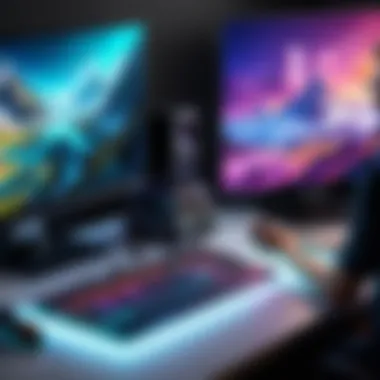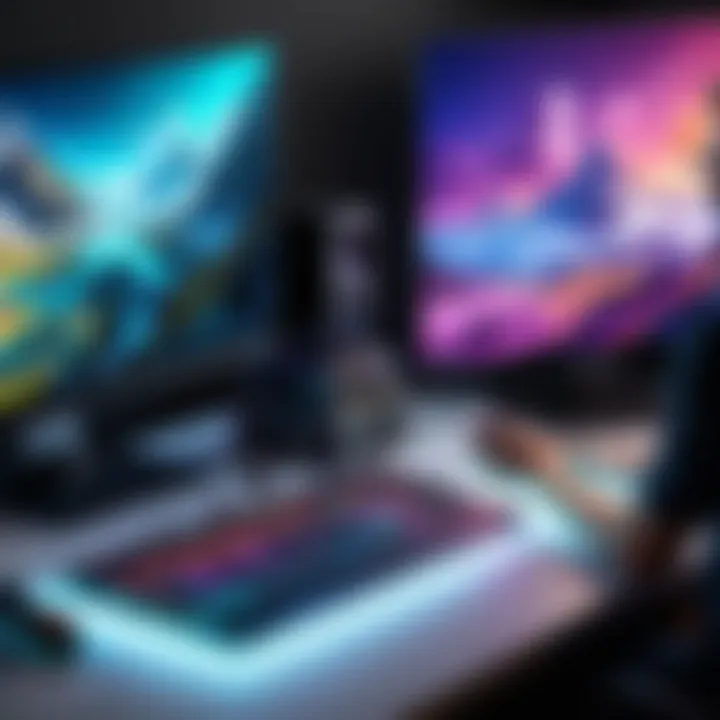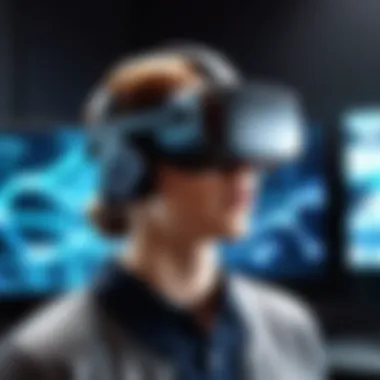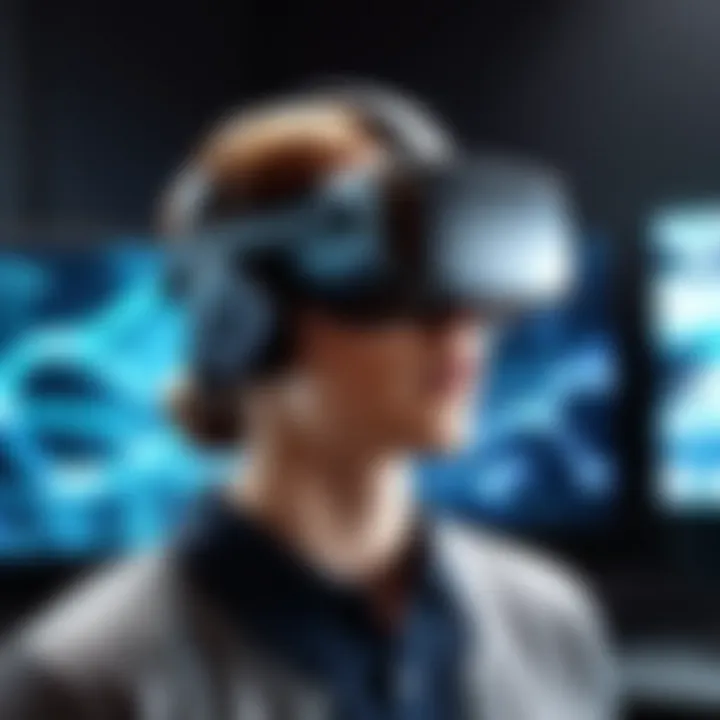Essential Tools for Video Game Designers Explained


Intro
In the evolving landscape of video game design, the selection of appropriate tools is crucial for success. Designers, regardless of experience, must navigate a plethora of software and hardware options tailored for various aspects of game creation. This article will systematically explore the essential tools that empower designers to bring their creative visions to life.
Brief Description
Video game design encompasses a variety of disciplines, each requiring specialized tools. This section provides an overview of prominent software tools that aid in design, development, and project management.
Key features and functionalities are integral to understanding how these tools enhance productivity and creativity.
Most software tools, such as Unity and Unreal Engine, offer robust environments for creating immersive experiences. These platforms facilitate 3D modeling, animation, and coding, among other functions. Additionally, tools like Adobe Photoshop and Blender cater to various aspects of art and design, allowing for intricate visual crafting.
System Requirements
To effectively utilize video game design tools, users must meet certain system requirements.
Hardware requirements typically include:
- A multi-core processor for efficient computing
- High RAM capacity to handle complex applications
- A powerful graphics card for rendering high-quality visuals
Software compatibility is also a key factor. Many design software tools require specific operating systems, such as Windows or macOS, alongside certain driver versions to ensure peak performance. Therefore, a comprehensive understanding of these requirements can prevent technical issues that disrupt the creative process.
"The right tools amplify creativity and streamline development, making them fundamental in video game design."
As video game design continues to evolve, knowledge of both established tools and emerging technologies is vital. Staying informed about industry trends enables designers to make informed decisions, ensuring their projects resonate in an increasingly competitive market.
In this exploration, we will cover various tools in detail, providing insights into their unique features, benefits, and best practices for usage to equip designers with comprehensive knowledge for their game development journey.
Intro
Understanding the various tools available for video game design is crucial in today’s digital landscape. Game design is an intricate process that requires not only creativity but also technical proficiency. Developers need to be equipped with a variety of tools that address different aspects of the game creation process. This article aims to provide a comprehensive overview of that essential toolkit.
Selecting the right software and hardware can make a marked difference in the efficiency and quality of game design projects. A proper understanding of these tools can help designers streamline workflows, improve collaboration, and most importantly, enhance the player experience.
Video game design tools can range from powerful game engines like Unity and Unreal Engine, to specialized software for sound and graphics. These tools can significantly affect the outcome of a project, impacting both development time and the final product’s quality.
"The tools a game designer chooses can shape every aspect of the game; from its look and feel, to how players engage and interact with the world.”
Additionally, with the rapid advancements in technology, keeping abreast of the latest tools is vital. Emerging technologies like virtual reality and artificial intelligence are not just trends; they are becoming central to the future of gaming. Understanding these trends can provide significant advantages.
In summary, this article serves as a guide designed for both novice and seasoned game designers. It aims to unpack each category of tools, discuss their relevance, and direct readers toward optimizing their game development processes. By engaging deeply with these tools, designers can ensure their projects are not only creatively fulfilling but also technically sound.
Understanding Game Design Tools
Understanding game design tools is crucial for creating engaging and immersive games. This section will analyze the various elements that comprise game design tools and their specific benefits in the game development process.
Definition of Game Design Tools
Game design tools refer to both software and hardware that support the various phases of game development. These tools assist in planning, designing, testing, and deploying video games. Essentially, they include components for graphic design, sound editing, programming, and project management. Each tool serves a unique purpose and helps streamline the development process. For instance, game engines provide a platform to build the actual gameplay experience, while graphic design software allows artists to create visual assets. By utilizing these tools, designers can enhance their creativity and productivity, leading to improved game quality.
Importance of Selecting the Right Tools
The selection of appropriate game design tools is significant for numerous reasons. Firstly, using the right tools can lead to increased efficiency. When designers have suitable software and hardware, they can work faster and with less friction. This efficiency is especially important in collaborative environments where time is often limited.
Moreover, different tools cater to varying skill levels and project scopes. A novice designer may prefer user-friendly software, such as Unity or Blender, which offers extensive tutorials and community support. In contrast, experienced developers may seek more advanced features found in tools like Unreal Engine. Thus, knowing where one stands in terms of skills and what is required for the project can guide the selection process.
Additionally, the right tools can foster creativity. Designers equipped with powerful software are free to experiment and innovate without being held back by limitations, encouraging unique game concepts.
The implications of tool selection extend beyond the immediate project. Using effective tools can help maintain a healthy team dynamic by reducing frustration and fostering collaboration. Ultimately, selecting the right tools is foundational for achieving desired outcomes, meeting deadlines, and pushing the boundaries of creativity in game design.
"The choice of tools can define the success of a game project. It influences creativity, efficiency, and the overall workflow of the design process."
By understanding and carefully choosing the game design tools available, designers can enhance their work environment and produce high-quality games that resonate with players.
Core Software Tools for Game Design
The realm of video game design is expansive and intricate. Central to this landscape are the core software tools that facilitate the various stages of the development process. These tools are not just optional; they are essential for creating immersive and engaging gaming experiences. They allow designers to conceptualize their ideas, build the game environments, implement sound, and test gameplay effectively.
Understanding the advantages and functions of different software tools can significantly elevate the quality of a game. For instance, game engines serve as the foundation for building the game itself, while graphic design software and sound design tools refine the visual and auditory aspects of the final product. Hence, selecting the appropriate tools can make the difference between a mediocre and a standout gaming experience.
Game Engines
Unity
Unity is a highly versatile game engine. Its wide range of features supports developers in creating both 2D and 3D games. One of the key characteristics of Unity is its user-friendliness. This makes it popular among both beginners and seasoned developers. The engine provides visual scripting through tools like Bolt, allowing those less familiar with coding to contribute to development.


A unique feature of Unity is its extensive asset store. It gives designers access to various pre-made tools, models, and scripts, which can expedite the development process. This can considerably lower development costs, though one must be cautious of reliance on purchased assets, which might affect a game's originality.
Unreal Engine
Unreal Engine stands out for its powerful capabilities and high-quality graphics. Its advanced rendering technology is advantageous for developers focusing on realistic visuals and complex physics. The key characteristic of Unreal Engine is its Blueprint visual scripting. This allows developers to create game logic without extensive programming knowledge.
Additionally, Unreal Engine offers a robust community and extensive documentation, which aids in learning and tackling challenges. However, the engine can be demanding on hardware, which may limit accessibility for smaller studios or independent developers.
Godot
Godot presents a unique approach as an open-source game engine that is light and adaptable. One of Godot's key characteristics is its scene system, which allows developers to organize game elements better. This promotes a modular approach to development, enhancing collaboration among team members.
A distinctive feature of Godot is its scripting language, GDScript, which is designed to be easy to learn. This is beneficial for newcomers. However, because it is less mainstream than Unity or Unreal, the availability of learning resources can be limited.
Graphics Design Software
Adobe Photoshop
Adobe Photoshop is a cornerstone of digital graphic design. For game designers, its powerful photo editing and graphic creation capabilities are invaluable. The key characteristic of Photoshop is its versatile toolset, which allows users to manipulate images with exceptional precision. This makes it a beneficial choice for creating textures and user interfaces.
A unique feature of Photoshop is its support for layer management. This function enables designers to work non-destructively, permitting continuous adjustments without altering the original assets. The downside is the software's subscription-based model, which can become costly over time.
Blender
Blender has emerged as a favorite among 3D artists due to its comprehensive capabilities. It offers modeling, animation, and rendering tools, making it a one-stop solution. The key characteristic of Blender is its open-source nature, which allows for continuous updates and community-driven improvements.
One notable feature of Blender is its sculpting tools, which can create highly detailed models. While this is an advantage for lifelike characters and environments, the steep learning curve can pose a challenge for beginners.
Substance Painter
Substance Painter specializes in texture painting, allowing designers to create complex materials that respond dynamically in engines like Unity and Unreal. The key characteristic of Substance Painter is its real-time feedback, which aids in achieving the desired look during the painting process.
A unique feature is its procedural effects, enabling the application of variations across surfaces. This adds depth and realism. However, because it's tailored for texture work, additional tools are still needed for modeling and animation, which may increase workflow complexity.
Sound Design Tools
Audacity
Audacity is a free, open-source audio editing tool commonly used for sound design. Its simplicity and straightforward interface make it easy to use. The key characteristic of Audacity is its powerful editing capabilities, including multi-track editing and effect applications. This makes it a popular choice for novice sound designers.
A unique feature of Audacity is its extensibility through plugins, which adds functionality. However, it may lack the comprehensive features found in paid software solutions, which could be a limitation as projects grow more complex.
FMOD
FMOD is a sophisticated audio tool designed for game development. Its integration with various game engines allows for seamless audio implementation. The key characteristic of FMOD is its adaptive audio capabilities, which adjust sound dynamically based on gameplay events. This flexibility is beneficial for creating immersive environments.
A unique feature is the event-based system, which simplifies sound triggering. While FMOD is powerful, it requires some technical knowledge, which might be a barrier for some users.
Wwise
Wwise serves as another popular tool in sound design for video games. It is known for its robust interactive music system. The key characteristic of Wwise is its comprehensive audio middleware, allowing designers to implement complex soundscapes effectively. This is crucial for creating an engaging audio experience.
One unique feature is its integration with various platforms and its focus on real-time sound adjustments. However, the complexity of the tool may pose challenges for beginners, making training necessary for effective use.
Prototyping and Development Tools
Prototyping and development tools play a vital role in the modern game design landscape. They facilitate the early stages of a game project, allowing designers to visualize ideas and concepts before full-scale development begins. These tools help bridge the gap between imagination and execution, ensuring projects remain coherent and aligned with initial visions. By using prototyping tools, creators can explore gameplay mechanics, test user experiences, and iterate rapidly based on feedback.
Moreover, effective prototyping tools offer significant advantages. They minimize the risk of extensive rework later in the process. Mistakes are easier to address in the early phases, ultimately saving time and resources. Development tools also enhance collaboration among team members, fostering a more integrated approach that can contribute to overall project success.
Wireframing and Mockup Tools
Wireframing and mockup tools are essential components of the prototyping stage. They allow designers to create visual representations of their concepts without diving into detailed programming. These tools focus on layout and user interface, helping teams communicate ideas more clearly.
Balsamiq
Balsamiq is a popular choice among designers for wireframing due to its simplicity and effectiveness. The tool emphasizes ease of use, enabling designers to create sketches of their ideas quickly. One of the key characteristics of Balsamiq is its drag-and-drop interface, allowing for fast prototyping.
A unique feature of Balsamiq is its library of pre-made user interface components. This enables users to assemble mockups without needing extensive design skills. The lightweight design helps maintain focus on functionality over aesthetics in the early stages of a project. However, Balsamiq may lack advanced features found in other tools, which could limit flexibility in some cases.
Figma
Figma offers a collaborative platform for wireframing and design, making it a robust tool for teams. A key characteristic of Figma is its real-time collaboration feature, which allows multiple users to work on a project simultaneously. This can enhance the creative process as ideas flow freely among team members.


One unique feature of Figma is its vector editing capabilities combined with prototyping tools. This offers designers the ability to craft refined interfaces while also building interactive prototypes. This blend of functions can be highly advantageous for teams looking to streamline their workflows. However, for solo developers, Figma’s vast capabilities might be overwhelming and not entirely necessary for all projects.
Version Control Systems
Version control systems are instrumental in game development, ensuring that changes to projects are tracked and managed effectively. They provide a structured environment for developers to collaborate while minimizing conflicts.
Git
Git is a highly regarded version control system popular among software developers. It excels in its ability to manage large codebases and has become a standard tool in the industry. One of Git's key characteristics is its distributed nature, allowing each collaborator to work independently while still contributing to a cohesive project.
A unique feature of Git is its branching model. This allows developers to create separate branches for new features or fixes and merge them back into the main project when complete. This can drastically reduce integration issues, although it requires developers to have a solid understanding of branching strategies to prevent confusion.
Subversion
Subversion, often abbreviated as SVN, provides an alternative to Git. It operates on a centralized model, which may be more familiar to teams transitioning from traditional file-sharing methods. One of Subversion's key characteristics is its clear history tracking of changes, making it easier to revert to previous versions if necessary.
A unique feature of Subversion is its ability to lock files. This is useful in situations where specific files should not be modified by multiple people simultaneously. While Subversion is beneficial for certain workflows, it may also limit flexibility for teams that desire the branching benefits provided by Git.
Collaboration and Project Management Tools
Collaboration and project management tools hold significant importance in the realm of video game design. The nature of game development often requires a mix of creativity, technical skill, and teamwork. Designers, artists, programmers, and producers all bring unique perspectives. Therefore, effective communication and organized project management become essential. Using the right tools can streamline workflows, enhance communication, and ultimately lead to a successful game development process.
Communication Platforms
Slack
Slack is a cloud-based communication platform designed to facilitate collaboration within teams. One specific aspect of Slack is its ability to create channels for different topics, projects, or teams. This feature enables focused discussions without the clutter of irrelevant conversations. Slack is a popular choice in the game design industry due to its user-friendly interface and integrations with other tools, such as Google Drive and Trello.
A unique feature of Slack is its emphasis on real-time messaging. Teams can exchange ideas quickly and share updates efficiently. However, one disadvantage can be information overload, as too many channels may lead to distractions. Keeping channel discussions organized is crucial to avoid this issue.
Microsoft Teams
Microsoft Teams serves as another key communication platform, particularly appealing to organizations already using Microsoft 365 applications. A notable aspect of Microsoft Teams is its seamless integration with Word, Excel, and other Microsoft products. This integration fosters a collaborative environment where documents can be edited together while discussing ideas.
Microsoft Teams also supports video conferencing, making it easier for remote teams to connect visually. This feature can enhance relationships among team members but may require a stable internet connection. A potential downside is that users often find the learning curve steep compared to other communication platforms.
Project Management Software
Trello
Trello is a visual project management tool that organizes tasks using a card-and-board system. This system allows for a straightforward representation of workflows. Teams can easily move tasks between different stages, such as "To Do," "In Progress," and "Done." Trello is beneficial in providing an overview of the entire project at a glance, making it simple to identify bottlenecks or areas needing attention.
A unique feature of Trello is its use of labels and due dates on cards. These attributes make it easier to prioritize tasks effectively. However, Trello can become overwhelming for larger teams, as it may lack the depth of features some larger projects require.
Asana
Asana is a comprehensive project management software that offers advanced task tracking and reporting capabilities. One specific aspect of Asana is its ability to set project milestones and timelines, which are essential in game development. Teams can visualize their deadlines and progress, allowing for better planning and accountability.
A standout feature of Asana is its workload management functionality, helping teams assess their capacities and redistribute tasks accordingly. This promotes a balanced distribution of work. A disadvantage may be that Asana's broad array of features can sometimes feel daunting for newcomers. Training might be needed to unlock its full potential.
"Effective collaboration tools are no longer optional; they are a fundamental component of successful game design projects."
Hardware Considerations
Understanding hardware considerations in video game design is essential. The choice of hardware influences both the development process and the final product's performance. Well-selected hardware can enhance efficiency and improve user experience, while inadequate hardware may lead to limitations and frustrations.
Gaming PCs and Consoles
Gaming PCs offer powerful performance and flexibility in game design. They can be customized with various components such as high-end graphics cards and processors to meet the demands of modern game development. Consoles, on the other hand, provide a standardized environment optimized for specific games. Both have their merits, and the choice between them often depends on the target audience. For professional designers, gaming PCs usually provide a superior option, allowing for broader development capabilities and testing across multiple platforms.
Input Devices and Accessories
Game Controllers
Game controllers are crucial for user interaction in video games. They provide intuitive controls, enabling players to engage with the game seamlessly. A key characteristic of game controllers is their ergonomic design, which allows for prolonged use without discomfort. This aspect makes them a popular choice for game developers aiming for user-friendly gameplay experiences. However, the uniqueness of a game controller lies in its various configurations and compatibility with different systems. This results in advantages such as improved responsiveness but also potential limitations with certain game types or user preferences.
VR Equipment
VR equipment is transforming the landscape of game design. It enables immersive experiences that draw players into virtual worlds. A primary characteristic of virtual reality technology is its ability to enhance the realism of gameplay through spatial awareness and motion tracking. This equipment is increasingly essential for developers focusing on innovative gameplay mechanics. While the advantages include increased engagement and interactivity, challenges remain regarding accessibility and potential motion sickness. Developers must consider these factors when integrating VR into their projects.
"The right hardware is as important as the right software in game design."
Emerging Technologies in Game Design


Emerging technologies are reshaping the landscape of game design. They represent a convergence of creativity and innovation, enabling designers to create more immersive experiences. Futuristic elements like Virtual Reality (VR) and Artificial Intelligence (AI) are not just trends; they are fundamentally altering how games are conceived, developed, and played. By leveraging these technologies, game designers can push the boundaries of storytelling, gameplay mechanics, and user interaction.
Virtual Reality Tools
Virtual Reality tools have gained significant traction in recent years. With the growing accessibility of VR hardware, such as Oculus Rift and HTC Vive, designers are presented with unique opportunities. VR offers players an experience that transcends traditional gaming interfaces. The immersive environments created through VR allow players to engage with virtual worlds in a way that feels intensely real.
Game designers must consider the specific needs of VR development. This includes the use of specialized software like Unity and Unreal Engine, both of which offer robust support for VR integration. These tools help in creating 3D models and simulations that are essential for effective VR experiences.
Moreover, understanding spatial audio technologies is crucial. Since sound plays a key role in immersion, utilizing sound design tools like Wwise can enhance the overall user experience. Designers must ensure that the soundscapes adapt to the player's movements, heightening the feeling of presence in the game world.
"Immersion through Virtual Reality is not just about visuals; it includes spatial audio, haptic feedback, and intuitive controls."
Artificial Intelligence in Game Development
Artificial Intelligence is another transformative force in game development. AI improves gameplay through non-player character (NPC) behavior, procedural content generation, and adaptive difficulty. These aspects greatly influence how players interact with the game environment.
For instance, AI can create realistic NPCs that learn from player interactions, offering a dynamic gaming experience. Tools like IBM Watson and Unity's ML-Agents are invaluable for incorporating AI. They allow designers to implement machine learning algorithms that adapt to the player's style and tactics.
Furthermore, AI can streamline development processes. By automating repetitive tasks, designers can focus more on creativity. This increase in efficiency can be particularly beneficial in larger projects where timelines are critical.
The integration of AI and machine learning not only enhances player engagement but also opens up new avenues for storytelling. Dynamic narratives that react to player actions create a distinct gameplay experience that can vary from session to session.
Industry Trends and Future Directions
In the rapidly evolving landscape of video game design, keeping an eye on industry trends and future directions is crucial. The tools and methodologies used by game designers are continuously changing, influenced by technological advancements, player expectations, and market demands. Understanding these trends helps designers make informed decisions about the tools and technologies they adopt in their projects.
Shifts in Game Design Methodologies
Game design methodologies have shifted significantly over the past few years. Traditional practices are now blending with agile and iterative approaches. This shift emphasizes flexibility, enabling teams to adapt quickly to feedback and changes during the development process. The focus is moving from a linear workflow to a more collaborative and iterative one.
Agile methodologies foster continuous improvement. Teams assess their progress often and adjust their strategies as needed. This change benefits designers significantly, as they can release prototypes early and gather feedback from players. As a consequence, the final game product is more likely to align with user expectations.
It's also worth noting the increasing use of data analytics in shaping game design. Designers are now leveraging player data to understand gaming behavior better and improve player engagement. This analytical approach allows for more targeted game features, enhancing player satisfaction.
Sustainability in Game Development
Sustainability has become a pressing concern in game development. The industry is recognizing its impact on the environment and is beginning to adopt practices that reduce this footprint. Sustainable gaming methods include minimizing energy consumption during game operation and optimizing server resources.
Furthermore, many game companies are now focusing on promoting eco-friendly practices. This includes using green technologies in the development process and raising awareness about environmental issues through their games. By emphasizing sustainability, developers not only contribute positively to the environment but also attract a growing audience who values corporate responsibility.
Adopting sustainable practices can provide a competitive edge and enhance a company’s reputation in the industry. As more players become eco-conscious, aligning game development practices with these values can lead to increased loyalty and a more engaged community.
In essence, the future of game design hinges on understanding shifting methodologies and embracing sustainability as a core principle of development.
Closure
In the realm of video game design, the conclusion serves a crucial role in synthesizing the previously discussed concepts. This article has examined various tools, both software and hardware, essential for creating effective and engaging games. Understanding how these tools interact with each stage of game development can greatly influence the quality of the final product.
The importance of selecting the right tools cannot be overstated. They determine the efficiency of the design process, impacting developments from initial concepts to prototype testing, and eventually to the launch of a game. Choosing the appropriate game engine, graphic design software, and sound tools can enhance collaboration, streamline work processes, and ultimately lead to a better gaming experience for the end-user.
Effective game development also depends on a solid understanding of emerging trends and innovations. As technologies evolve, designers must adapt and stay informed of how advancements in virtual reality and artificial intelligence can be leveraged. These elements add layers of complexity and depth to gameplay, engaging users more than ever.
Furthermore, rising trends in sustainability present additional considerations for contemporary designers. Designing games that are not only entertaining but also mindful of environmental impacts adds a meaningful dimension to the development process.
"Tools are only as good as the design thought behind them – choose wisely, create thoughtfully."
Further Reading and Resources
In the realm of video game design, the pursuit of knowledge extends beyond just the tools used in the industry. Further reading and resources provide an essential foundation for any designer looking to stay updated and informed. Engaging with additional materials allows professionals to deepen their understanding of complex topics, explore innovative techniques, and discover the latest trends shaping the landscape of game development.
Importance of Further Reading
The exploration of comprehensive resources enriches a designer’s skill set and broadens their perspective. Consider that game design is an ever-evolving discipline, influenced by technological advancements, player preferences, and market dynamics. Therefore, keeping abreast of changes through reputable sources proves critical.
- Staying Informed: Regularly consuming literature, articles, and case studies can inform designers about the newest methodologies and tools. This habit fosters adaptability, crucial in a rapidly changing industry.
- Learning from Experts: Access to insights shared by seasoned professionals illuminates best practices and potential pitfalls. Books and journals authored by industry leaders can provide guidance that is not always obtainable through formal education.
- Enhancing Creativity: Further reading often introduces fresh ideas and innovative approaches. This influx of new concepts can inspire designers to experiment, ultimately improving their projects and pushing the creative boundaries of their work.
Recommended Resources
Here is a brief compilation of valuable resources that can enhance a game designer’s toolkit:
- Books:
- Online Platforms:
- "The Art of Game Design: A Book of Lenses" by Jesse Schell
- "Rules of Play: Game Design Fundamentals" by Katie Salen and Eric Zimmerman
- Wikipedia - Offers broad knowledge on various topics related to game design.
- Britannica - Provides authoritative information that can support research efforts.
- Reddit - Subreddits, such as r/gamedesign, are vibrant communities where designers can share knowledge, resources, and feedback.
Finale
As designers navigate their careers, the importance of continuous learning cannot be overstated. This investment in knowledge ultimately leads to more successful and innovative game development.



